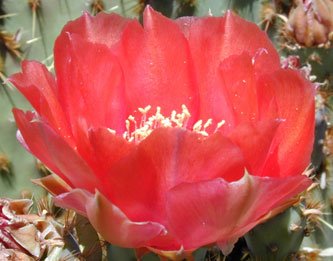First you drive the two-lane across the high desert of Idaho, toward a place called Craters of the Moon, which pretty much describes the barrenness of the landscape.

Forty-plus miles west of Idaho Falls, a square brick block of a building hunches all by itself on the windswept plain. Isolation was the plan and isolation was what they got.

A perky young lady offered us a guided tour, which we wisely declined because we spent far more time on certain displays than I’m sure any one else would have. The brochure for the self-guided tour and the displays provided an excellent lay-person’s explanation of both the processes involved and the significance of the work. Of course, both Al and I may have a bit more education along these lines than the average tourist, but we found the whole exhibit informative and interesting.
The facility was built on a former Navy test firing range immediately after WWII and it is awe-inspiring to realize how these dedicated men and women created the peaceful atom using technology that now seems absurdly primitive. This view of the control room shows panels of analog equipment, pens scribing lines on rotating discs of graph paper and the kind of dials that are now laughingly referred to as steam-gauges when they are on our airplane control panel.
 Fascinated, Al read the corporate names on the instrumentation, a litany of by-gone manufacturers, most of them dating back to before the time of dinosaurs when he went to engineering school, and most of them as extinct as the dinosaurs or long since merged with today’s corporations.
Fascinated, Al read the corporate names on the instrumentation, a litany of by-gone manufacturers, most of them dating back to before the time of dinosaurs when he went to engineering school, and most of them as extinct as the dinosaurs or long since merged with today’s corporations.The facility was decommissioned over forty years ago and any radioactive materials have long been hauled away to what is, I’m sure, some nice secure nuclear waste storage area. Today, you can look right into the heart of the reactor and understand the mechanics of bringing the fissile materials together to create nuclear reactions. Uranium and plutonium are incredibly dense and heavy, so there is a lot of material handling equipment, much of which was designed to be used by remote control. You can even try your hand at manipulating a robot arm to stack blocks. It’s all very interesting if you are a science/engineering nerd.
Al was especially delighted that there was a large-format thick paperback book explaining the history of this facility as well as the other nuclear installations that have been built in the area and it was available for the asking. I’m sure most people don’t ask, but he spoke to the tour guide and she said she’d give him one before we left. She greeted us near the end of our self-guided tour and presented him with his very own copy of "Proving the Principle, a history of the Idaho National Engineering and Environmental Lab."
I had felt bad that our would-be guide had no takers for the tour while we were there, but she filled me in on some of the “interesting” people she encounters. We agreed that the general public has very little understanding of nuclear issues because of the deplorably low level of science education and also the fact that it is a difficult subject. Much easier to listen to the radicals on both sides who tell you what to believe. It seems that the anti-nuke crowd comes in to see the devil in person. She has had visitors come in with face masks to avoid breathing in the contaminated air. The day before we we were there, one visitor had pulled the hair of the other guide, convinced that it was a wig because she must surely be suffering from radiation sickness and losing her hair. Almost worse are the know-it-alls who come up with arcane questions to stump this poor intern who is studying communications at university, not nuclear engineering. People are truly amazing, sometimes even more so than nuclear reactions.


0 Comments:
Post a Comment
<< Home